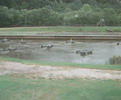Lagoon Systems - 1...
Aerated Lagoons...

Aerated lagoons are relatively shallow lagoons in which wastewater is added at a single point either at the edge or middle
of the lagoon and the effluent is removed from another point. The retention time is a function of the percent removal of
BOD. The retention time may vary from 6 to 18 days as the removal of BOD from domestic wastewater varies from 75 to 90 percent. Oxygen is supplied by means of surface aerators or by diffused aeration units. The action of the aerators also maintains the solids of the lagoon in suspension. Depending on the degree of mixing, lagoons may be operated as either aerobic or as aerobic-anaerobic systems.
In aerobic lagoons all biological solids are in continual suspension and stabilization of the organics occurs under aerobic conditions. In the case of the aerobic-anaerobic lagoon a large portion of the solids settles to the bottom of the lagoon.
As the solids build up, a portion will undergo anaerobic decomposition. Therefore, stabilization in this case occurs partly under aerobic conditions and partly under anaerobic conditions.
Stabilization Ponds...
A stabilization pond or "oxidation pond" as it is often called, is usually a shallow earthen basin of controlled shape,
which is designed for treating wastewaters from small communities or industrial plants. The ponds are usually 2 to 4 feet deep, although much deeper ponds have been used quite successfully. Stabilization ponds have been applied singly as part of
a treatment scheme or as the sole process, providing complete treatment.
The process involves two major steps in the decomposition of organic matter in wastewater. The carbonaceous matter is first oxidized by the aerobic microorganisms with the formation of carbon dioxide and the inorganic forms of nitrogen and phosphorous. These inorganic forms are then used by algae in their photosynthetic reactions. Photosynthesis is a natural process carried on by green plants in the presence of light. One of the end products of photosynthesis is oxygen which becomes available to the aerobic microorganisms. As a result of the reactions in the ponds, the organics in wastewater are partly oxidized and partly converted to algae cells. Algae has been harvested in some of the locations and used for animal feed as a protein source. Therefore, treatment of wastewater with the production of a useful by-product is possible in
stabilization ponds.
Most stabilization ponds are designed for loadings of one acre per 400 persons, 50 pounds of BOD per acre per day or 15 pounds of BOD per acre foot per day with detention periods generally greater than 30 days. The natural soil in which they
are located should be fairly impervious so that seepage will not materially affect the surface level of the wastewater in
the pond.
These ponds are low cost in construction and require a minimum of operation. The requirement that large, fairly isolated areas be provided limits their use to relatively small populations in areas where land is available.
Pond Performance...
The treatment efficiencies that can be expected by ponds vary more than most other treatment devices. Some of the many variables are :
Physical Factors...
- Type of soil.
- Surface area.
- Depth.
- Wind action.
- Sunlight.
- Temperature.
- Short circuiting.
- Inflow variations.
Chemical Factors...
- Organic material.
- pH.
- Solids.
- Concentration and nature of waste.
Biological Factors...
- Type of bacteria.
- Type and quantity of algae.
- Activity of organisms.
- Nutrient deficiencies.
- Toxic concentrations.
Operation and Maintenance...
Most problems that arise from ponds area result of the operator's neglect and poor housekeeping practices. Some operation
and maintenance problems associated with ponds are :
Scum Control...
Scum is a common characteristic usually present in the spring when the water warms and the biological activity resumes.
Scum can promote a blue-green algae growth which can give rise to disagreeable odors. If scum is allowed to accumulate,
it can cut off the sunlight from the pond which would affect the dissolved oxygen produced from photosynthesis.
Odor Control...
Odors are usually associated with overloading and poor housekeeping. Most odors usually occur during the spring warm-up
when biological activity resumes. Reduction of odors can be accomplished by the use of surface aerators and the addition
of chlorine. In some cases, sodium nitrate has been used as a supplemental source of oxygen.
Weed Control...
Weeds are mostly objectionable because they can promote mosquito breeding and scum accumulation. Aquatic weed roots may puncture pond linings and hinder pond circulation.
Insect Control...
Mosquitoes will breed in sheltered areas of standing water, where there is vegetation or scum to which female mosquitoes
can attach their eggs. Mosquitoes are a nuisance to plant personnel and nearby residential areas and may pose public health problems. There are also many minute, shrimp-like predators which feed on algae, usually during the warmer months, and may
clear the pond of algae, reducing the dissolved oxygen content in the pond and producing noxious odors. This condition is normally temporary. Effective insect control is usually accomplished by good housekeeping practices and the use of insecticides.





